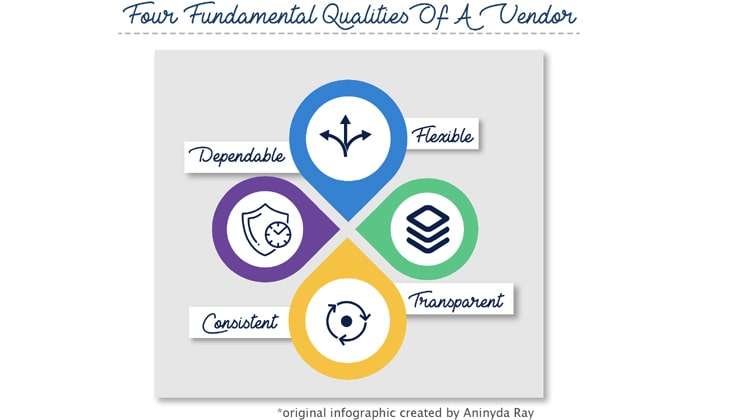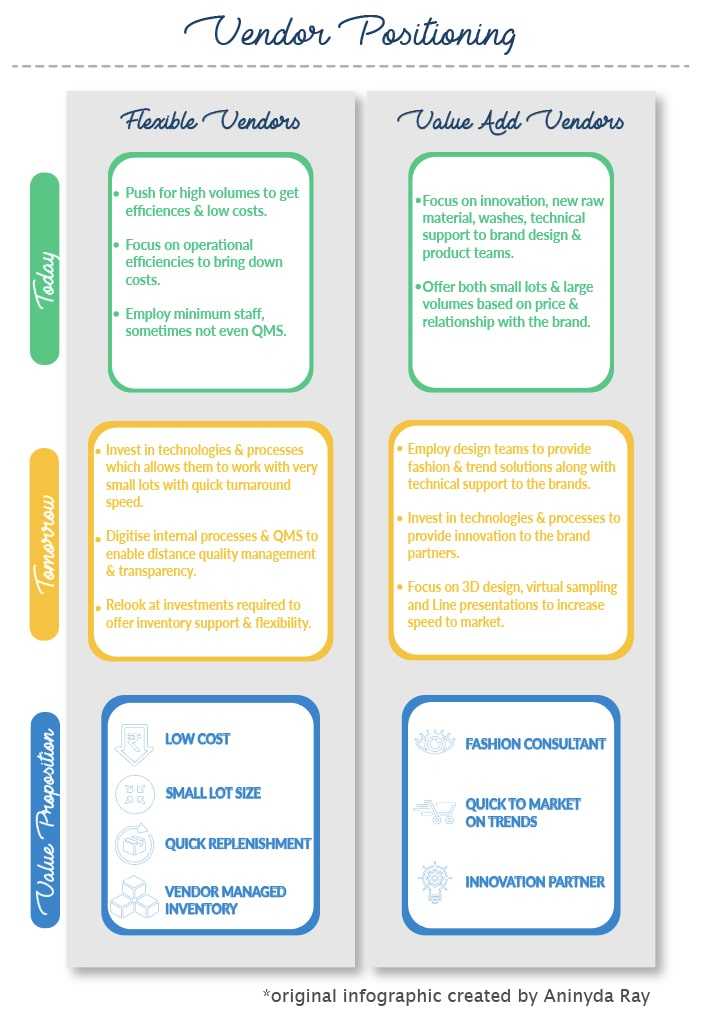
The most obvious question these days is how to become a preferred vendor in this new emerging market?
I am writing this feature because I was asked this question during my session in the ASW Marketplace in Dec ’20 on ‘the future of sourcing’. How to become a preferred vendor? It is a very relevant question and one that requires a more detailed discussion.
Vendors are the backbone of the fashion retail industry. It is they who execute the brands vision and give life to the products. A collaborative union of a brand and a vendor can do wonders in this industry. But how does a vendor become a preferred one?
For the purpose of this feature, the words brand and retailer have been used interchangeably.
Here, I seek answers to this question by dwelling on the following points:
– The basic qualities brands look for in a vendor
– Understanding the evolving requirements of brands
– How should the vendor position his business?
Having spent many years in this industry, I have come across many different kinds of vendors. Big, small, specialised, full service providers and so on. They all aspire to work with big brands and retailers. While they are able to procure orders for a season or two, many are unable to impress the brand teams and build long-term partnerships.
One may debate about lack of capabilities, infrastructure or high costs as the reasons behind it. But I believe the answer lies elsewhere. They need to demonstrate the four fundamental qualities which are:

DEPENDABLE – Meeting commitments is the stepping stone of dependability. Vendors who meet their time commitments, within cost parameters and requisite quality are always desired by the brands. They are considered dependable as they don’t just deliver the product on time, but can be trusted to deliver quality product.
CONSISTENT – “Every time, on time” is a mantra every vendor needs to follow. Clubbed with consistency in quality and costs, this becomes the secret of success for many. Many reputed vendors formally brief their customers about this regularly, reiterating their reputation as a consistent performer. This builds trust and reliability, thus helping build a long-term business with them season on season.
TRANSPARENT – One of the most important aspects in building trust in business is transparency. A vendor who is transparent about costing, compliances, dealings with nominated vendors as well as daily/weekly status is always preferred by the brands. They build confidence in the buyers and compel them to work with the vendor again and again.
FLEXIBLE – Business by definition is dynamic. In many cases vendor support becomes the need of the hour. This support may vary from holding the goods to reprioritising for early deliveries, reworking commercial terms, changes in shipping instructions or quick turnaround. By extending this support and being flexible, the vendor goes closer to empathising with the brand and their requirement. This building of trust allows the brand/retailer to see the vendor as a partner.
If a vendor is unable to deliver on these 4 fundamental qualities, it becomes very difficult for them to earn the brands’ trust and ensure long-term business.
To move further we need to understand:
The Evolving Requirement of Brands
The circumstances today are fast evolving. Businesses are under immense pressure to become more and more efficient. Markets are becoming dynamic, trends are evolving at a much faster pace, go to market cycles are reduced. In such a scenario, brands are looking for more from the vendors.
Handling smaller volumes with ease, taking on some of the inventory pressures of brands, adjustable working in terms of delivery phasing, innovation and design partnership are a few such additional propositions.
And this is where I see as an opportunity for vendors to become preferred ones. So, how should a vendor approach this opportunity? It is by positioning his business properly. So we now come to:
How should a Vendor position his Business?
In the yesteryears, vendors used to clearly position themselves as – Low cost, High Quality or Specialist Vendors and some vendors and agents used to position themselves as Design and development partners. But are these positions sustainable? For a few years maybe, but as brands keep evolving, this will change.
In this fast evolving market, the dynamics of what brands are looking for is changing. A simple way of looking at it is, by positioning himself either as a Flexible Vendor or a Value Add Vendor . The graphic below throws light on what this really means for a vendor.

Vendor needs to develop a positioning strategy. The first step in doing so, is to understand what his brand’s business is and how is the brand looking at his factory. Then he needs to understand where he can position himself and accordingly deliver. He needs to answer what is beyond the fundamental requirements that he is offering to the brand:
Is he becoming an innovation partner or
a trend translator and design partner?
Is he taking some of the brands inventory pressures or
is he reducing his working capital requirements?
Is he supporting with shorter lead times or
Is he managing demand pull based production?
I would simply suggest that vendors need to look beyond just cost and design to become brands on their own. Trusted for their commitments and valued for what they bring on board for their brand partners.
Today, businesses are looking at vendors who mirror them and work hand-in-hand with them. Gone are the days where the relationship was of a customer and buyer. Today it is about partnership and collaboration. A vendor who can become a true collaborator is the one who will become a preferred vendor.
Well, I would love to hear your thoughts on the same. Please do comment and share your views with me on this.
– Anindya Ray

Post a Comment